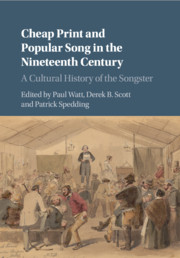Book contents
- Cheap Print and Popular Song in the Nineteenth Century
- Cheap Print and Popular Song in the Nineteenth Century
- Copyright page
- Contents
- Figures
- Tables
- Contributors
- Acknowledgements
- 1 The Nineteenth-Century Songster: Recovering a Lost Musical Artefact
- Part 1 Production, Function and Commerce
- 2 American Secular Songsters in the Nineteenth Century: An Overview
- 3 The Prefaces to Songsters: The Law, Aesthetics, Performers and Their Reputations
- 4 The Genesis of Thomas Moore’s Irish Melodies, 1808–1834
- Part 2 Politics
- Part 3 Nation, Place and Purpose
- Index
- References
4 - The Genesis of Thomas Moore’s Irish Melodies, 1808–1834
from Part 1 - Production, Function and Commerce
Published online by Cambridge University Press: 07 April 2017
- Cheap Print and Popular Song in the Nineteenth Century
- Cheap Print and Popular Song in the Nineteenth Century
- Copyright page
- Contents
- Figures
- Tables
- Contributors
- Acknowledgements
- 1 The Nineteenth-Century Songster: Recovering a Lost Musical Artefact
- Part 1 Production, Function and Commerce
- 2 American Secular Songsters in the Nineteenth Century: An Overview
- 3 The Prefaces to Songsters: The Law, Aesthetics, Performers and Their Reputations
- 4 The Genesis of Thomas Moore’s Irish Melodies, 1808–1834
- Part 2 Politics
- Part 3 Nation, Place and Purpose
- Index
- References
Summary

- Type
- Chapter
- Information
- Cheap Print and Popular Song in the Nineteenth CenturyA Cultural History of the Songster, pp. 47 - 70Publisher: Cambridge University PressPrint publication year: 2017
References
References
Archives
The Gibson-Massie Moore Collection (c. 966 volumes) of monographs and sheet music was largely assembled by the Belfast collector, Andrew Gibson (fl. 1904–1927) during the late nineteenth and early twentieth centuries. Since its acquisition in 1960, Queen’s has continued to supplement this collection of early and posthumous editions of Moore’s work, which represents the breadth and diversity of his output. Particular strengths are the variant issues and editions of Moore’s Irish Melodies and his Lalla Rookh, some bound in fine and ornate bindings, while still others are decorated by prominent illustrators. Two online exhibitions at the McClay library’s Special Collections complement the present study: ‘Thomas Moore and the Printer’s Devils’; ‘Thomas Moore Music Project’ at cdm15979.contentdm.oclc.org/cdm/landingpage/collection/p15979coll12. Queen’s Special Collections also holds the Bunting Collection (c. 250 items), which comprises the manuscripts (music and text), notebooks and photographs associated with Edward Bunting (1773–1843) and the Belfast Harpers Festival of 1792. For digital material related to this collection, as well as the Irish Song project, see digital-library.qub.ac.uk (this is an alternative route to the two Moore exhibits).
- 2
- Cited by

